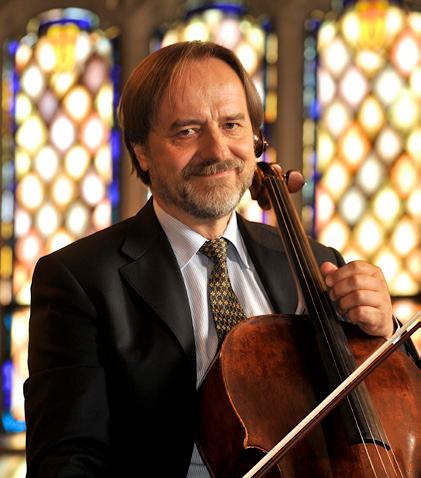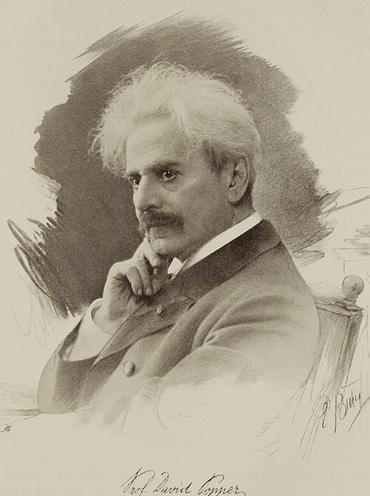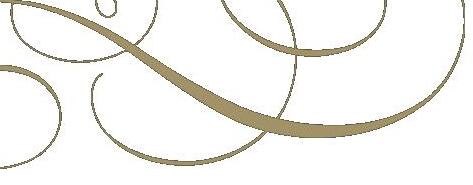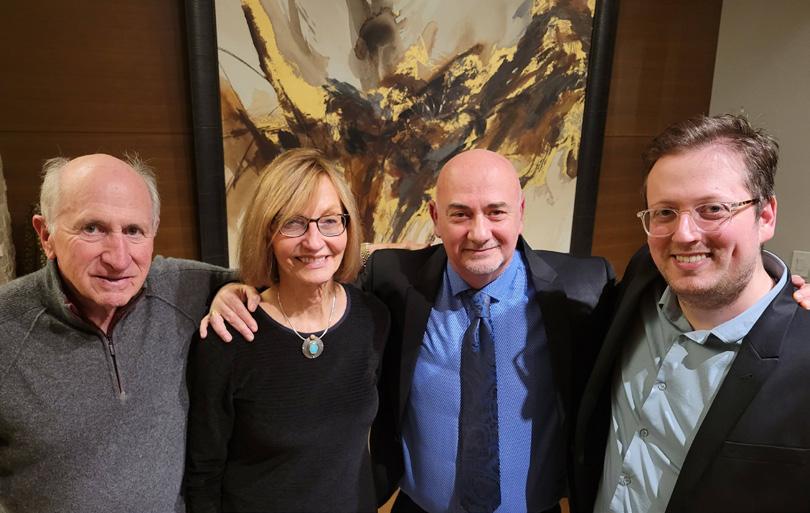


Sayevich
Park University International Center for Music Presents the
Daniel Veis cello




Sayevich
Park University International Center for Music Presents the
Daniel Veis cello
Friday, January 24, 2025 • 7:30 p.m.
1900 Building • Mission Woods, KS





Dear Esteemed Patrons and Lovers of Music,
As we embark on a new season at the International Center for Music at Park University, I find myself reflecting on the profound impact that music has on our lives. It’s not just the sound that resonates, but the emotion and dedication behind every performance that truly moves us. As Artistic Director and founder of this institution, I am continuously inspired by the exceptional talents of our students, faculty, and guest artists who pour their hearts into their craft. Kansas City is a remarkable place, home to a community that cherishes and supports the arts with unparalleled enthusiasm. Our concert series is designed to bring you closer to the magic of live music, offering an intimate and accessible way to experience the brilliance of our performers.
Our mission remains steadfast: to create an environment where musical excellence thrives, free from the distractions and financial burdens that often hinder artistic growth. At Park ICM, we are committed to nurturing the next generation of musicians with the same intensity and focus that shaped my own musical journey.
This season, we are proud to present a lineup that includes not only our extraordinary students and faculty but also internationally acclaimed guest artists whose contributions to the world of music are nothing short of legendary. In keeping with our mission, we will also introduce you to the newborn stars, the bright talents who represent the future of classical music. Each concert is an opportunity to witness the convergence of passion, discipline, and talent, creating moments that linger in the heart and mind.
I invite you to join us in celebrating the transformative power of music. Your presence and support are invaluable to us, fueling our drive to reach new heights of artistic achievement. Together, let’s create a symphony of shared experiences that transcends time and space.
With deep gratitude,


Stanislav Ioudenitch Founder and Artistic Director International Center for Music at Park University
P.S. Each performance is a manifestation of our shared love for music. Your presence and applause amplify our drive to elevate the art form further.
Ben Sayevich, violin
Lolita Lisovskaya-Sayevich, piano
Daniel Veis, cello

Lithuanian-Israeli violinist Ben Sayevich has established himself as one of the most distinguished violinists and teachers of his generation. He has performed in concert extensively throughout North America, Europe and the Far East, and he has appeared on radio and television as a soloist and chamber musician.
He is featured as the soloist in a recording of Vivaldi’s “The Four Seasons” with the Kansas City Chamber Orchestra. At the New England Conservatory of Music, he was chosen to play the Violin Concerto by Alban Berg for the celebration of the composer’s centenary. Sayevich’s interpretation carries the tradition that comes down directly from the composer, through his work on the piece with the late Louis Krasner, the commissioner, dedicatee and the violinist at the work’s premiere.
His extensive activities with orchestras have included concertmaster posts at the Kansas City Camerata and the Kansas City Chamber Orchestra, with both making numerous concerto appearances, including violin concertos by Vieuxtemps, Glazunov, Mozart and Beethoven. He was also concertmaster of the Heidelberg Chamber Orchestra during a five-week world tour of Japan, Singapore and Canada.
Sayevich also maintains a vigorous schedule as chamber musician. He is a founding member of the Park Piano Trio, established at Park University in 2006, and is violinist of the London-based Rosamunde Piano Trio. With the Rosamunde Trio, he has performed widely in Europe, including appearances on BBC Radio London, Irish Public Radio in Cork and the Abbado Festival Bologna. He is also a founding member of Quartet Accorda, which began in the 1990s and was officially incorporated in 2002. Sayevich has taught at the University of Kansas, the Grieg Academy in Bergen, Norway, the New England Conservatory of Music, the Hartt School of Music and the Yellow Barn Music Festival in Vermont.
Born in Kaunas, Lithuania, he studied violin in Vilnius from the age of 6 at the Churlonis School for the Performing Arts. At 12, he immigrated to Israel with his family and studied with Felix Andrievsky. At age 21, after serving in the Israeli army, he went to the U.S. to study with Dorothy DeLay, later moving to the New England Conservatory of Music to continue studies with her and Eric Rosenblith. He is a recipient of the prestigious artist diploma from the New England Conservatory of Music, where he was Rosenblith’s teaching assistant.

Born into a Tashkent (Uzbekistan) musical family, Lolita Lisovskaya-Sayevich began studying piano at the age of 4. In 1985, she entered the Uspensky Central Music School in Tashkent. In 1993, she started attending a private school for young musicians in Moscow, and that same year received the first prize at the Chopin International Piano Competition in Göttingen, Germany. She entered the Tchaikovsky Special Music School in 1995, and two years later was accepted to the Tchaikovsky Moscow Conservatory under the tutelage of Vera Gornostaeva, with whom she continued postgraduate study from 2002 to 2004. Lisovskaya-Sayevich also studied with Stanislav Ioudenitch at Park University.
In 1996, Lisovskaya-Sayevich received the first prize from the Nikolai Rubinstein International Piano Competition, and in 2007 the first prize at the Iowa International Piano Competition. She was awarded scholarships from the Rostropovich Foundation, the Spivakov Foundation and the Nikolai Petrov Foundation. She has also earned the laureate designation from the international program “New Names,” and the festival “Virtuoso 2000” in St. Petersburg, Russia. Lisovskaya-Sayevich has recorded at the Hessen Radio Station in Frankfurt, Germany, and at Orfei Radio in Moscow.
Lisovskaya-Sayevich has presented numerous solo recitals and has played as a soloist with orchestras in Austria, France, Japan, Spain, Germany, Hungary, Italy and Russia. She has participated in many music festivals, including the Bashmet Festival in Tours, France, “Wave 2000” in Japan, International Musical Arts Institute in Maine (USA), Killington Music Festival in Vermont (USA), “Ars Longa” and “Primavera Classica” in Moscow. She has collaborated with such renowned musicians as Daniel Muller-Shott, Shmuel Ashkenazy, members of the Boston Symphony Orchestra and many others. She now performs extensively in chamber music ensembles.

Daniel Veis has been widely recognized as the finest Czech cellist since winning the Silver Medal at the prestigious 1978 Tchaikovsky International Competition, Moscow, and the First Prize at the 1976 Prague Spring International Competition.
He started his musical studies in his native Prague and proceeded to the Moscow Tchaikovsky Conservatoire furthering his studies with the famous Natalia Shakhovskaya, graduating with full distinction. Since 1979 he has performed regularly as a soloist with many major orchestras in such respected venues as Avery Fisher Hall and Carnegie Hall NY, Royal Albert Hall, Purcell Room, Wigmore Hall and Kings Place (London), Orchard Hall (Tokyo), Auditorí de Barcelona, Auditorio National de Madrid, Neues Gewandhaus Leipzig and Festsaal Dresden, and all major halls in Czechoslovakia including Rudolfinum and Smetana Hall in Prague.
He has worked with world famous conductors (V. Neumann, Sir Ch. Mackerras, S. Baudo, L. Pesek, J. Belohlavek, G. Deluge, O. Danon, Y.P. Tortelier, Ch. Seaman, J.P. Saraste) and outstanding musicians (J. Panenka, V. Snitil, L.Kavakos, A. Levine, K.W. Park, D. Poppen and P. Neubauer).
As a regular guest Veis has been invited to various international festivals ( Prague Spring, Schumann- Zwickau, Bodensee-Fridrichshaven, Polenca -Mallorca, Canarias, Ex Toto Corte- Saõ Paolo, Victoria International Arts- Malta). His repertoire is vast and diverse and includes a large number of contemporary compositions, some of them dedicated to him.
For various labels he has recorded complete cello works by Brahms, Schumann, Mendelssohn-Bartholdy, Martinu and concertos by Dvořák, Brahms, Saint-Saens, Sommer and Vella. For several years Veis held the position of guest soloist for the Czech Philharmonic Orchestra, and as a founding member of Dvorak Trio he has recorded with this group complete trios by Dvořák and Martinu as well as trios by Brahms, Smetana, Tchaikovsky, Suk etc..
As a sought after teacher he led the cello studio at the Prague Academy of Performing Arts where he also held the position of Head of Strings. During this period he brought up a number of excellent cellists who are now principals and members of major orchestra and chamber groups. In 2010 Veis was invited to lead the Cello Studio at the International Center for Music at Park University. He is a member of the Park Trio and a founding member of in London-based Rosamunde Trio. Veis regularly performs in the UK, Germany, Austria, France, Japan, Brazil, China and the USA, and is frequently invited to judge international competitions.

Russia in the late-19th century experienced one of the great flowerings of classical music in history. Some of the same feudal structures that had spurred patronage in Europe also encouraged artworks of extreme sophistication in Russia. Ballet and opera flourished, concert music was a popular pastime, and instrumental virtuosos toured the world.
In addition to the great composers we know and love from these decades — Tchaikovsky, Rimsky-Korsakov, Glazunov — a great many lesser-known but gifted composers were active during this time: artists whose music has been largely swept aside. One such figure was Anton Arensky, who composed prolifically during his brief life — he died of tuberculosis at age 44 — but is known for only a handful of works.
Photo: Damian Gonzalez
Arensky grew up in an affluent home in Novgorod (also the birthplace of Rachmaninoff, whom Arensky would later teach). His mother was an exceptional pianist and his first teacher, and by age nine he was already composing. The family moved to St. Petersburg when Anton was 16, and soon afterward the precocious boy took up studies with Rimsky-Korsakov at the Conservatory. Graduating in 1882, the talented young pianist/composer almost immediately earned a teaching post at the Moscow Conservatory.
He gained much from Rimsky-Korsakov in terms of structural innovation and orchestral style, but his musical heart followed that of the more conservative Tchaikovsky. “In his youth, Arensky did not escape some influence from me: later, the influence came from Tchaikovsky,” Rimsky-Korsakov wrote, with a vague tone of disapproval. (The composer of Scheherazade is also the main source of the oft-repeated information that Arensky was a gambler and drinker whose early death was the result of a life of dissipation.)
Arensky was an influential teacher, counting Scriabin, Rachmaninoff, and Glier among his pupils, and from 1895 to 1901 he also served as music director of the Imperial Chapel at St. Petersburg. He toured widely, both as pianist and conductor. Among his works are three operas — including Raphael on the life of the Renaissance painter and an Indian epic Nal and Damayanti on a libretto by Modest Tchaikovsky. He wrote cantatas, a ballet Egyptian Nights, two
symphonies, concertos for piano and violin, and chamber music including string quartets, piano trios, and other works.
His set of Variations on a Theme of Tchaikovsky (1894) paid homage to his late friend, who had died the year before. Arensky’s largest output was for solo piano, including some works that are no doubt worthy but still awaiting “discovery” by the musical public at large.
Tchaikovsky perhaps started a trend when he chose the medium of piano trio for his Trio in A minor (In Memory of a Great Artist), his 1882 homage to his beloved Nikolai Rubinstein, who had died the previous year. Rachmaninoff’s Trio élégiaque No. 2, in turn, was composed in 1893 as a tribute to the recently deceased Tchaikovsky. Likewise, Arensky’s Trio No. 1 from 1894 was dedicated to the late Karl Davidov, who had died five years earlier. Davidov had been director of the St. Petersburg Conservatory during Arensky’s period of study there, and he was also one of the finest cellists of the era.
As such, the trio features an unusually prominent role for the cello, with plaintive melodies that suggest not only the powerful impact of Davidov’s death but also the above-mentioned “elegiac” trios. (Davidov is also famous for having owned a 1712 Stradivarius cello that came to bear his name, which was later played by Jacqueline du Pré and, more recently, Yo-Yo Ma.)
Arensky’s Trio No. 1 is by far his most well-known composition, and for good reason: With shadings of Mendelssohnian charm and Tchaikovskian gravity, it appeals to the psyche with its deft craftsmanship and grabs the heart with its sheer sincerity. The discursive opening movement (Allegro moderato) features passionate themes for violin and, especially, cello: Some commentators have suggested the movement is a tribute to Davidov’s warm, generous personality. Lament alternates with vigor, all placed within a traditional sonata-form complete with recapitulation and a final coda.
The Scherzo (Allegro molto) conveys a quicksilver mood, the Trio a contrasting vigor. The heartbreaking opening theme of the Elegia (Adagio) is give first to the cello and then to the violin, both muted, before the piano is allowed to tone in. It surely counts as one of the most beautiful melodies of Russian chamber music; it gives way to an equally winning theme in the piano, which provides a hint of respite from the tristesse. The final Allegro molto charges forward with a renewed sense of fervor and determination.
Beginning in the early 1860s, Dvorák produced a steady stream of inspired and idiomatic trios, quartets, quintets, and sextets, and by the end of his career he had some 40 chamber works to his name — nearly twice as many as his mentor and friend Johannes Brahms. Dvořák’s works are strongly oriented toward strings, with or without piano: there are no fewer than 14 string quartets, two piano quintets, two string quintets, four piano trios, and an extensive catalogue of works for violin or cello and piano.

Chamber works appear during every stage of Dvorák’s career, and the trends found in these smaller-scale works tend to mirror, and sometimes foreshadow, those found in the large milestones. A new spirit is felt in Dvořák’s chamber music beginning in the late 1870s — a decisive move toward structural complexity and sophisticated lyricism that would ultimately find echo in his larger works. Various influences are heard throughout these mature works, from composers such as Mendelssohn, Wagner, and Brahms. Yet there is no lack of Bohemian and, more broadly, Slavic elements in these works, often manifested through the use of folk tunes or regional dance styles.
The word dumka seems to have origins in the Ukrainian word duma (a thought, refection, or contemplation), of which dumka is a diminutive. As a musical form, the dumka contains characteristics that vary widely. Dvořák used the term for works of a meditative mood, but he extended the genre by making many of his dumky (plural of dumka) into parings of lyrical passages with strongly contrasting, often wildly rhythmic ones.
“Dvořák’s conception of a dumka gradually crystallized into a musical form,” biographer John Clapham writes, “the basic mood of which is pensive and melancholy, but which has sections interpolated that are serene, cheerful, and even sometimes exceptionally ebullient.”
Dvořák included dumky in several works even before the famous Op. 90, but none possesses the subtlety or finesse of this later work. Composed from November 1890 to February 1892, the Dumky Trio is one of the most
imaginatively designed chamber works of its time — at once a series of dances and, simultaneously, a sort of complex sonata form that leaves the listener with a sense of an organic whole.
The Dumky appears to have been deliberately created so as to appeal both to the connoisseur and to the general public, and thus is not nearly as weighty as the magisterial F-minor Trio, Op. 65. The composer wrote to his friend Alois Göbl that he was working on “a little piece for violin, cello and piano: It will be both happy and sad. In some places it will be like a melancholic song, at others like a merry dance. But overall the style will be lighter or, if I might put it another way, more popular — in short, so that it will appeal to both higher and lower echelons.” Indeed, after taking part in its premiere in Prague in April 1891 — with two of his closest friends, violinist Ferdinand Lachner and cellist Hanuš Wihan — the composer and his colleagues took the work on a 40-concert “farewell tour” throughout Bohemia and Moravia. It was greeted with success throughout these travels, which were organized in anticipation of his departure for the United States in 1892. Simrock published the Trio in 1894.
The Trio consists of six dances in the dumka tradition, though in fact each of the six movements is a singular creation. Some have suggested that the trio alludes to sonata form, with the first three dumky forming an expansive opening movement. Yet this idea excludes the notion that Dvořák determined to create an innovative structure happily free from the strictures of classical sonata form.
The design of keys in the six movements — E minor, C-sharp minor, A major, D minor, E-flat major, C minor — also suggests a certain freedom from a form-driven mindset. “The form of the piece is structurally simple but emotionally complicated,” writes critic Daniel Felsenfeld, “being an uninhibited Bohemian lament.”
The fourth dumka contains a primary march theme that recurs several times, and the fifth is cheerful and quick-footed. The final dumka is again built from strongly contrasting themes that seem to summarize the dualistic nature of the whole piece. It sends us off with a Vivace of foot-stamping vigor.







The Park University International Center for Music Foundation exists to secure philanthropic resources that will provide direct and substantial support to the educational and promotional initiatives of the International Center for Music at Park University. With unwavering commitment, the Foundation endeavors to enhance awareness and broaden audiences across local, national, and international spheres.
Vince Clark, Chair
Steve Karbank, Secretary
Marilyn Brewster
Lisa Browar
Stanley Fisher
Brad Freilich
Ron Nolan
Shane Smeed
Benny Lee, Treasurer
John Starr
Steve Swartzman
Guy Townsend
Angela Walker
Karen Yungmeyer


Stanislav Ioudenitch, Founder & Artistic Director, Piano Studio
Behzod Abduraimov, Artist-in-Residence
Gustavo Fernandez Agreda, ICM Coordinator
Peter Chun, Viola Studio
Lolita Lisovskaya-Sayevich, Director of Collaborative Piano
Steven McDonald, Director of Orchestra
Ben Sayevich, Violin Studio
Daniel Veis, Cello Studio


The Orchestra for the International Center for Music will present its annual Valentine’s concert on Friday, February 7, 7:30 P.M., at the gorgeous Graham Tyler Memorial Chapel at Park University. The program will be under the direction of guest conductor, Jason Seber, known for his inviting and engaging approach on and o the podium. Seber has conducted many leading American orchestras, including the Colorado, Detroit, Houston, Indianapolis, Kansas City, Milwaukee, Nashville, National, San Diego, and St. Louis Symphonies, the Louisville and Minnesota Orchestra, the Cincinnati Pops, and the Bu alo Philharmonic, among others.
FRIDAY • FEBRUARY 7, 2025
7 : 30 P.M.
GR A H A M T YL E R
M E MORI A L C H A PEL AT PAR K UN I VE R SI T Y.
FREE WITH RESERVATION







Support the ICM, enjoy beautiful music and special events just for members.
Patrons Society members enjoy exclusive invitations to group events including meeting the talented ICM artists.

For more information on how to join our Patrons Society, scan the QR code with your mobile device camera.



The Park University International Center for Music’s Patrons Society was founded to help students achieve their dreams of having distinguished professional careers on the concert stage.
Just as our faculty’s coaching is so fundamental to our students’ success, our Patrons’ backing provides direct support for our exceptionally talented students, concert season, outreach programs and our ability to impact the communities we serve through extraordinary musical performances.
We are continually grateful for each and every one of our Patrons Society members. For additional information, please visit ICM.PARK.EDU under “Support Us.”
We gratefully acknowledge these donors as of January 3, 2025.
Brad and Marilyn Brewster *
Steven Karbank
Benny and Edith Lee
Ronald and Phyllis Nolan
John and Debbie Starr
Steven and Evelina Swartzman
Jerry White and Cyprienne Simchowitz *
Jeffrey Anthony
Brad and Theresa Freilich
Shirley and Barnett C. Helzberg Jr. *
Holly Nielsen
Steinway Piano Gallery of Kansas City
Gary and Lynette Wages
Vince and Julie Clark
Stanley Fisher and Rita Zhorov *
Susan Morgenthaler *
Rob and Joelle Smith *
Kay Barnes and Thomas Van Dyke
Lisa Browar
Mark and Gaye Cohen
Suzanne Crandall
Charles and Patty Garney *
Doris Hamilton and Myron Sildon
Colleen and Ihab Hassan
Lisa Hickok and Brian McCallister *
William and Regina Kort
Jackie and John Middelkamp *
Kathleen Oldham
Kevin and Jeanette Prenger, ’09 / ECCO Select
James and Laurie Rote *
Stanley and Kathleen Shaffer
Guy Townsend
John and Angela Walker *
Nicole and Myron Wang*
Phil and Barbara Wassmer *
* 2024-2025 Member


MARCH 1, 2025 • 7 P.M.
PRESENTED BY PARK UNIVERSITY
Join us at our highly anticipated annual gala, “Stanislav & Friends: Echoes of Spain.”
Immerse yourself in an evening of passion and talent as we showcase the rich tapestry of Spanish melodies and rhythms. “I look forward to sharing the stage with a stellar lineup of musicians at this all-star gala event, where there might just be a very special surprise in store for our guests,” says Ioudenitch.



David Radzynski and Lolita Lisovskaya-Sayevich in CO N C E R T
Friday • March 14, 2025 • 7:30 p.m.
1900 BUILDING • MISSION WOODS, KS
St. 3 0 9 S Stewart Rd, L A P R I L 2 7t h , 7:3 0 PM
Experience the exceptional musicality of violinist David Radzynski, former concertmaster of The Cleveland Orchestra, and Park ICM Director of Collaborative Piano, Lolita Lisovskaya-Sayevich. David’s illustrious journey from ICM to leading roles with some of the world’s greatest orchestras, and now to concert violinist, when combined with the virtuosity of pianist Lolita, results in a recital that showcases the height of instrumental mastery.
C oncert i s FR E E of cha
S C AN HE R E TO RE presents David Radzynski and Lolita Lisovskaya-Sayevich IN CONCERT
Scan for tickets! or visit icm.park.edu

No t i ckets ed but PARK.


Imagine hearing — and seeing — every keystroke of a world-class piano performance in your own home. With spirio , you can enjoy music captured by renowned pianists, played with such nuance, power, and passion that it is utterly indistinguishable from a live performance.
Thousands of recordings by steinway artists are available at the touch of a button on the included iPad.
The library of music, videos, and playlists expands monthly and spans all genres. In addition to today’s greatest musicians, spirio delivers historic performances by steinway immortals , including Duke Ellington, Glenn Gould, Art Tatum, and many more.









- Becky N. Lowry, MD Physician Internal Medicine
For me, there’s nothing more rewarding than the meaningful connections I make with my patients. Maybe it’s growing up in a small town where those personal values remain strong. Or maybe it’s the belief, shared with all of my co-workers, that people come first. Whatever it is, the opportunity to provide care is a privilege I never forget. To schedule an appointment, call 913-588-1227 or visit KansasHealthSystem.com/Appointments.



